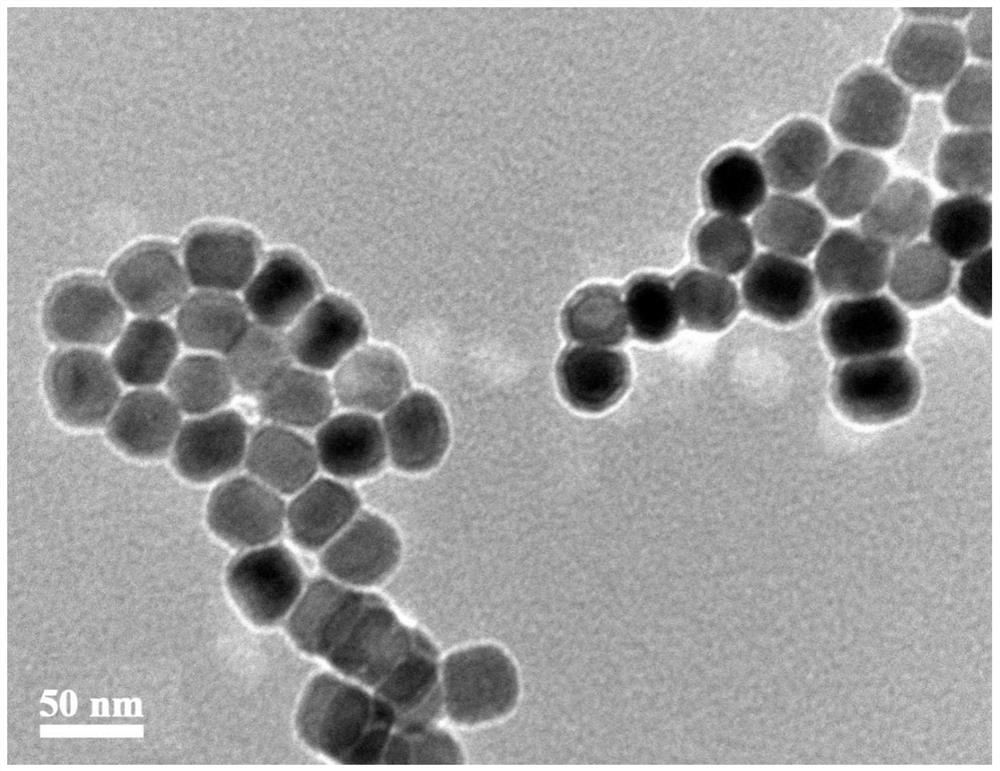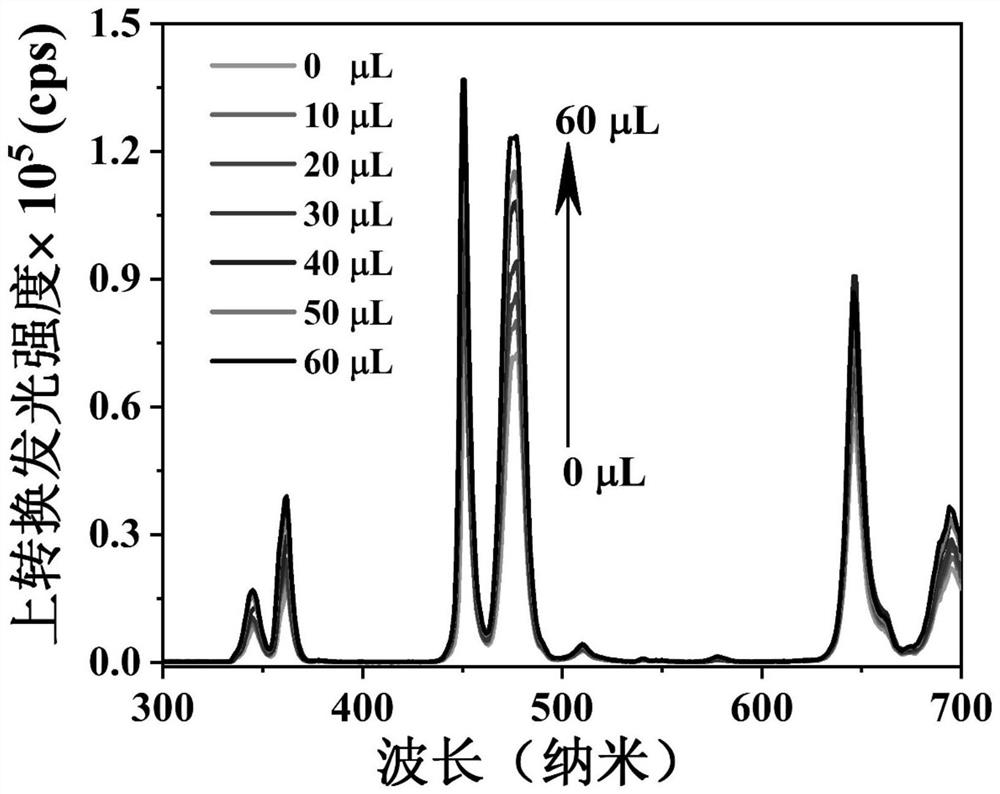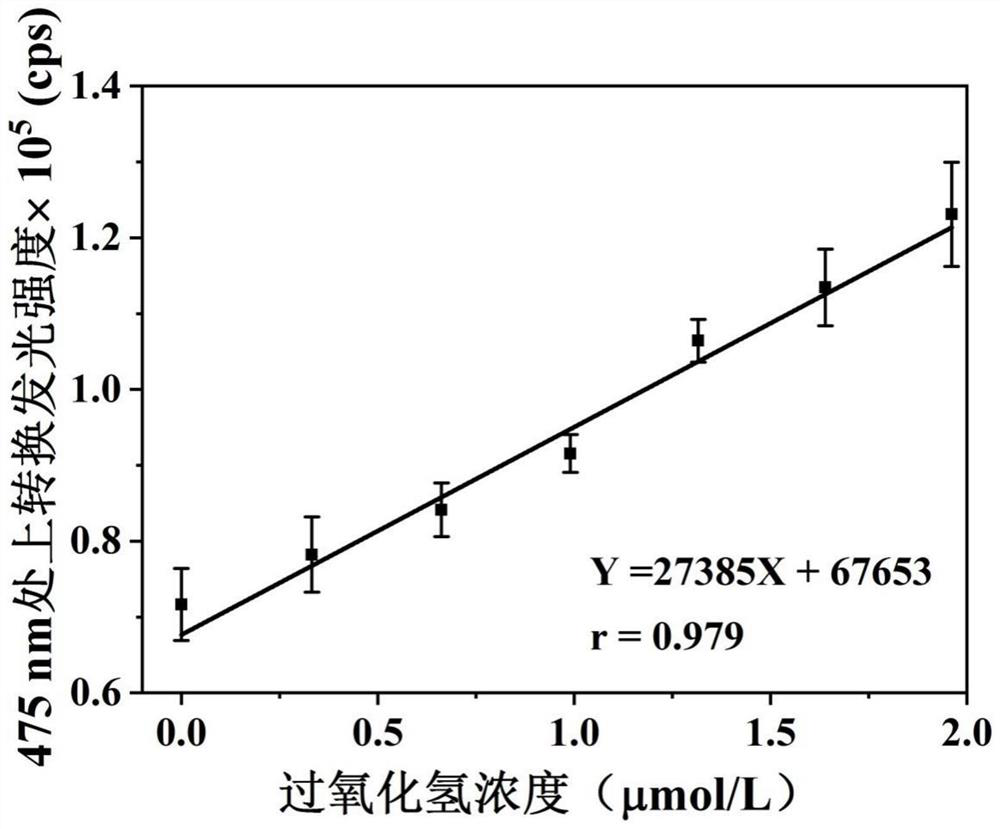Nano biosensor for detecting concentration of hydrogen peroxide, and preparation method and application of nano biosensor
A hydrogen peroxide concentration and biosensor technology, applied in the field of preparation and nano-biosensors, can solve the problems of low sensing signal strength, not easy to stabilize mass production, limited source of components, etc., to achieve high sensing signal strength, The effect of low cost and simplified preparation process
- Summary
- Abstract
- Description
- Claims
- Application Information
AI Technical Summary
Problems solved by technology
Method used
Image
Examples
Embodiment 1
[0037] The nano-biosensor using up-conversion luminescence to detect the concentration of hydrogen peroxide provided in this example is based on rare-earth up-conversion luminescence nanoparticles and histamine derivatives, specifically the rare-earth up-conversion luminescence nanoparticles NaYF synthesized by thermal coprecipitation method 4 : Yb / Er / Tm as the substrate, through the epoxidation of the oleic acid ligand on the surface of the substrate, a ring-opening addition reaction occurs with the electron-donating ligand with an amino group, and the electron-donating ligand is bonded to the up-conversion luminescent nanometer On the surface of the particle, under the irradiation of 365nm ultraviolet light, a layer of metallic silver is grown in situ on the surface of the up-conversion luminescent nanoparticles by means of photogenerated free electron reduction, forming up-conversion luminescent nanoparticles with a surface of metallic silver and a core of rare earth. Nano-b...
Embodiment 2
[0048] The nano-biosensor, preparation method and application provided in this example for detecting the concentration of hydrogen peroxide using up-conversion luminescence are basically the same as in Example 1, except that the preparation method uses rare earth up-conversion luminescence nanoparticles NaYF 4 : Yb / Tm as the basis, including the following steps:
[0049] (1) Preparation of electron-donating ligand: 0.2-0.4 g of histamine and 50-100 mg of NHS were ultrasonically dissolved in deionized water, magnetically stirred at a speed of 600-800 rpm, and kept stirring at room temperature for 12 hour, after fully mixing evenly, add 2mL serine aqueous solution (0.1~0.2g / mL) dropwise, continue stirring at room temperature for 12 hours, remove most of the solvent by rotary evaporator, and dilute to 2 with deionized water ~4mL, the first dispersion was obtained.
[0050] (2) Preparation of sensor precursor: prepare 10mL rare earth up-conversion luminescence nanoparticles NaYF ...
Embodiment 3
[0054]The nano-biosensor, preparation method and application provided in this example are basically the same as those in Examples 1 and 2, except that the preparation method uses rare earth upconversion luminescence Nanoparticles NaYbF 4 :Tm as the basis, including the following steps:
[0055] (1) Preparation of electron-donating ligand: 0.4 g of histamine and 100 mg of NHS were ultrasonically dissolved in deionized water, magnetically stirred at a speed of 800 rpm, and kept stirring at room temperature for 12 hours. , add 2 mL of serine aqueous solution (0.2 g / mL) dropwise, continue to stir at room temperature for 12 hours, remove most of the solvent by rotary evaporator, and dilute to 4 mL with deionized water to obtain the first dispersion.
[0056] (2) Preparation of sensor precursor: prepare 10 mL of rare earth up-conversion luminescent nanoparticles NaYbF 4 : Tm cyclohexane dispersion, prepare 50mL of 1,2-ethylene dichloride, mix with a volume ratio of 1:5, add 0.25g ...
PUM
 Login to View More
Login to View More Abstract
Description
Claims
Application Information
 Login to View More
Login to View More - R&D
- Intellectual Property
- Life Sciences
- Materials
- Tech Scout
- Unparalleled Data Quality
- Higher Quality Content
- 60% Fewer Hallucinations
Browse by: Latest US Patents, China's latest patents, Technical Efficacy Thesaurus, Application Domain, Technology Topic, Popular Technical Reports.
© 2025 PatSnap. All rights reserved.Legal|Privacy policy|Modern Slavery Act Transparency Statement|Sitemap|About US| Contact US: help@patsnap.com



